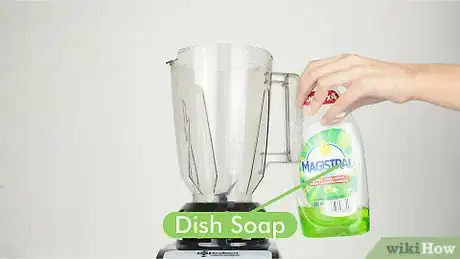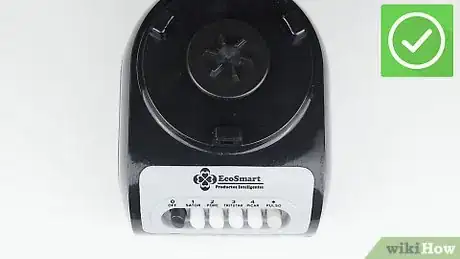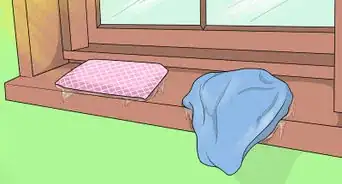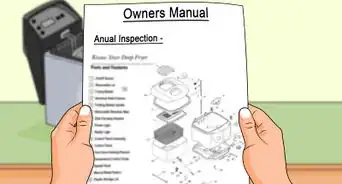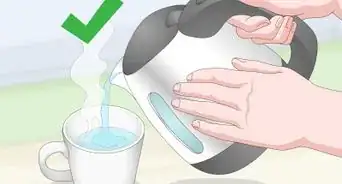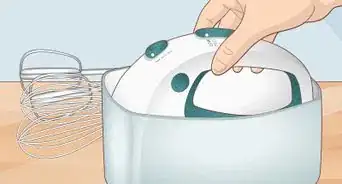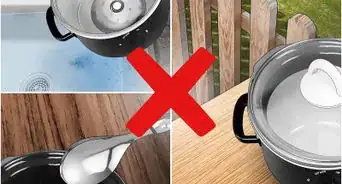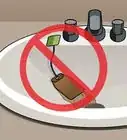This article was co-authored by Alessandra Mendes. Alessandra Mendes is a Cleaning Specialist and the Founder of Cleaning Glow. With ten years of experience, Alessandra and her team specialize in providing residential cleaning services in the San Francisco Bay Area. All members of the Cleaning Glow team have completed thorough background checks.
There are 7 references cited in this article, which can be found at the bottom of the page.
wikiHow marks an article as reader-approved once it receives enough positive feedback. In this case, 84% of readers who voted found the article helpful, earning it our reader-approved status.
This article has been viewed 171,578 times.
Cleaning a blender is easy if you clean it right after you use it! You can scrub it with a sponge for a deep clean, or you can blend water with dish soap for a quick and efficient clean. If you can't clean the blender immediately, then at least fill it with a soap-and-water mixture to soak while you're away.
Steps
Cleaning the Carafe
-
1Blend dish soap. Fill the blender carafe halfway with warm water. Then, add a few drops of liquid dish detergent. Blend on a low setting for about 20 seconds, or until the carafe is sudsy. Then, pour out the soupy liquid and rinse.
- Make sure that the lid is secure! If the lid comes off, then you'll get soapy water everywhere!
-
2Use a lemon to remove stains. Fill the blender halfway with water and a few drops of dish soap. Then, add half a lemon, coarsely chopped. Blend the mixture for a minute or so. The treatment should wash out the stains and leave the blender carafe looking fresh.[1]
- Alternately, use a few drops of white vinegar instead of the lemon. This may not smell as pleasant as the lemon, but it should be about as effective.[2]
Advertisement -
3Scrub stubborn stains. Use a rough sponge, steel wool, or a toothbrush, depending on the strength of the caked-on matter. Put a bit of water and dish soap into the blender, and then chip away at the stains with your rubbing tool until they disappear.
-
4Soak a very dirty blender overnight. Use a mixture of baking soda, vinegar, and dish soap. First, pour a cup of white vinegar into the carafe. Then. add a few drops of liquid dish detergent and about a half-cup of baking soda. Let the mix bubble to the top and subside. Blend the mixture together, and then let it soak into the carafe for at least a few hours.[3]
- After a few hours have passed, pour the mixture out into the sink. Rinse out the blender carafe until it is completely clean. If the blender still smells like baking soda and vinegar, consider doing a quick blend-and-soak with only dish soap and water.
-
5Allow the blender to air-dry. After you clean the inside of the carafe, leave the jug upside-down on a drying rack. At the very least, wait to put the lid back onto the blender jug until the inside is completely dry. A moist interior can lead to condensation and provide an environment for bacterial growth.
Cleaning the Base
-
1Wipe down the base. Soak a sponge or towel in warm, soapy water, and then wring it out until it is damp. Gently run the fabric over the base of the blender to clean off any places where food or liquid has spilled. Pay special attention to areas with dried or caked-on blended matter.
- Do not wash the base! The base houses the electronic motor and control system for the appliance. These parts will not stand up well to extended moisture exposure. Keep your cleaning efforts purely to the exterior, and absolutely do not submerge the whole base in water.
-
2Clean the base before it dries. The base will be more difficult to clean once blended food and liquids have caked onto the surface. Certain substances might become sticky as they dry, and others might even stain the material!
-
3Use a Q-tip to clean control buttons. If there is a buildup of blended gunk in the cracks around the blender's control interface, then it might be hard to get everything out with a sponge or rag. Dip a Q-tip in rubbing alcohol, then use it to wipe around the gunky buttons. The rubbing alcohol should dissolve caked-on matter and leave your blender a bit more pleasant to use.[4]
- The rubbing alcohol should dry quickly and evaporate. If any moisture remains on the blender base, wipe it away with a dry towel.
-
4Finished.
Cleaning the Blades
-
1Remove and clean separately. If your blender blades are still dirty after you blend dish soap and clean the carafe, then you may need to wash them separately. Remove the blender jug from the base, and then unscrew the blades from the bottom of the blender jug. Hand-wash them with dish soap and hot water. Scrub with a sponge or toothbrush to remove tough bits.
-
2Use polident tablets.[5] This is a good option if the blender blades are extremely dirty. Remove the blades from the blender jug. Then, submerge them in water with one of two polident tablets. The polident should clear up any tough stains.[6]
- If you don't want to remove the blades, you can always just clean them in the carafe. Pour in enough hot water to cover the blades, and then drop in two tablets of polident. Let soak for at least half an hour.
- Polident is a commercial tooth-whitening and antibacterial agent. You should be able to find the tablets in drugstores and grocery stores.
-
3Lubricate the gasket. When you're putting the blades back into the blender, take a moment to care for the gasket: the rubber piece that separates the jug from the base. Pour a tablespoon of olive oil or vegetable oil over the gasket to make sure that it remains flexible.[7]
Community Q&A
Did you know you can get answers researched by wikiHow Staff?
Unlock staff-researched answers by supporting wikiHow
-
QuestionThe buttons on my blender are filthy but I can't get my fingers in to clean them - what can I do?
 wikiHow Staff EditorThis answer was written by one of our trained team of researchers who validated it for accuracy and comprehensiveness.
wikiHow Staff EditorThis answer was written by one of our trained team of researchers who validated it for accuracy and comprehensiveness.
Staff Answer wikiHow Staff EditorStaff AnswerTry using a soft nail brush to gently scrub between the buttons on the blender. Use warm water (you can add a little bit of dish detergent if needed) and dip the brush into this. Shake to ensure the brush is not wet, just moist, then scrub the button area gently. Repeat until all the grime has been removed. Or, try the cotton bud method shown in the article above.
wikiHow Staff EditorStaff AnswerTry using a soft nail brush to gently scrub between the buttons on the blender. Use warm water (you can add a little bit of dish detergent if needed) and dip the brush into this. Shake to ensure the brush is not wet, just moist, then scrub the button area gently. Repeat until all the grime has been removed. Or, try the cotton bud method shown in the article above. -
QuestionIn the past I used to whir the blades on a blender to make sure they were dry, because of the motor. Does this apply anymore?
 Community AnswerThat is a good idea. You should keep doing that, though if you want to be more efficient, you could clean the blades with a water and soap soaked cloth.
Community AnswerThat is a good idea. You should keep doing that, though if you want to be more efficient, you could clean the blades with a water and soap soaked cloth. -
QuestionHow do I repair a loose blender blade?
 MicheleTop AnswererBlender blades are usually soldered to the base. If it's loose, the blade assembly with blade will have to be replaced. Call the manufacturer if it's still under warranty or to purchase a replacement blade.
MicheleTop AnswererBlender blades are usually soldered to the base. If it's loose, the blade assembly with blade will have to be replaced. Call the manufacturer if it's still under warranty or to purchase a replacement blade.
Warnings
- Take care when handling the blender blades.⧼thumbs_response⧽
- Take care to remove the cord from the power socket before wiping down the base with a damp cloth.⧼thumbs_response⧽
- Make sure the spout is closed when you are blending the cleaning liquid.⧼thumbs_response⧽
References
- ↑ http://www.thekitchn.com/clean-your-blender-tips-from-the-kitchn-199583
- ↑ https://www.thekitchn.com/how-to-clean-a-blender-in-30-seconds-without-taking-it-apart-first-cleaning-lessons-from-the-kitchn-200776
- ↑ http://www.everydaytastiness.com/2014/03/how-to-clean-vitamix-and-remove-blender.html
- ↑ https://www.angieslist.com/articles/how-to-clean-your-blender.htm
- ↑ https://brightnest.com/todos/clean-your-blender
- ↑ http://www.chowhound.com/post/cleaning-blender-blade-814800
- ↑ https://brightnest.com/todos/clean-your-blender
- https://www.youtube.com/watch?v=BKlPotWoUP4
About This Article
To clean a blender, blend warm water and dish soap in it and then rinse it out thoroughly. If there are any stubborn stains, add white vinegar or chopped lemon to the warm water before you blend it. For a really dirty blender, blend vinegar, baking soda, and dish soap in it and then let it sit overnight with the mixture inside. If there are still stains after that, you may need to scrub the blender with a rough sponge or steel wool. If you need to learn how to clean the base or blades of your blender, keep reading the article!
